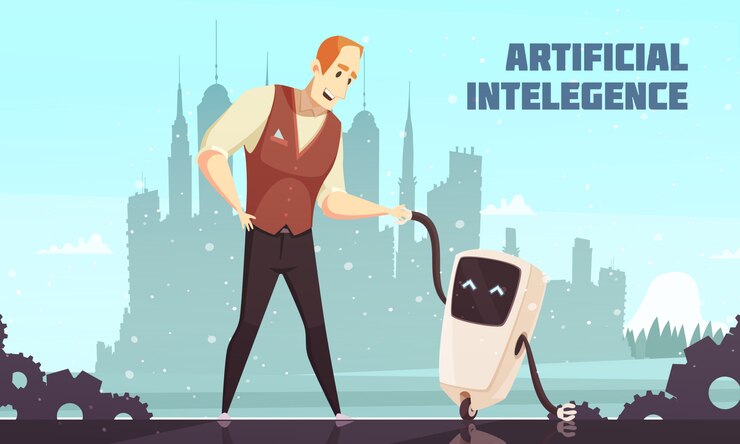Artificial Intelligence requires no formal introduction due to its widespread use and extensive scope. It has transcended the status of a mere buzzword and is now an integral part of our daily lives. As companies develop intelligent machines for various applications using AI, it is reshaping business sectors in unprecedented ways.
Artificial Intelligence employs intricate algorithms and techniques to develop autonomous decision-making machines, with Machine Learning and Deep Learning constituting the foundational elements of AI.
In this article penned down by the experts of the best web design company in Delhi, author is discussing about Artificial Intelligence Types, you will gain insights into the different phases and classifications of AI:
Artificial Narrow Intelligence (ANI)
It is also known as Weak AI which is has specialized AI systems designed for specific tasks. These systems excel in performing predefined functions within a narrow domain but lack the comprehensive cognitive abilities associated with human intelligence. ANI is task-specific, such as virtual personal assistants, image recognition software, or language translation tools, and operates within the confines of its programmed capabilities.
Unlike more advanced forms of AI, ANI does not possess the capacity for generalized learning or understanding beyond its designated functions, making it limited in scope but highly effective within its predefined parameters.
Examples include virtual personal assistants, image recognition software, and language translation tools.
Artificial General Intelligence (AGI)
It represents the theoretical pinnacle of artificial intelligence, aspiring to endow machines with human-like cognitive capabilities. Unlike current narrow AI, AGI would possess the capacity to understand, learn, and apply knowledge across diverse tasks, akin to human intelligence.
This hypothetical level of AI aims for a broad spectrum of cognitive abilities, allowing machines to adapt to new situations, comprehend complex scenarios, and engage in creative problem-solving.
For examples Customer service Chatbots, Voice assistants like Siri and Alexa, Recommendation engines like Google, Netflix, and Spotify and Self-driving cars
Artificial Superintelligence (ASI)
It represents a theoretical level of artificial intelligence surpassing human cognitive abilities across all domains. This speculative concept envisions a machine intelligence that not only mimics human intellectual capabilities but significantly exceeds them, potentially outperforming humans in creativity, problem-solving, and decision-making.
ASI raises profound ethical and existential questions, as its unprecedented cognitive superiority could lead to unpredictable consequences. The development of ASI is a subject of debate and caution within the AI community.
It emphasizes the need for careful ethical considerations and regulatory frameworks to guide its potential realization and mitigate risks associated with superintelligent systems.
Reactive Machines
Reactive Machines, the fourth type of artificial intelligence, operate solely based on predefined rules and programmed responses without the ability to learn or adapt to new situations. These systems excel at executing specific tasks but lack the capacity to evolve through experience.
Unlike learning-based AI, such as Limited Memory models, Reactive Machines do not incorporate historical data or modify their behaviour over time.
Reactive Machines showcase deterministic behavior, executing tasks according to programmed instructions without the capacity for autonomous learning or decision-making beyond their predetermined algorithms.
Example: IBM’s Deep Blue, which defeated chess world champion Garry Kasparov in 1997.
Limited Memory
It means artificial intelligence systems that can learn from past data and experiences to make decisions. Unlike reactive machines that operate based on predefined rules, limited memory AI has the capability to adapt to new situations and improve its performance over time.
These systems use historical information to enhance their decision-making processes, allowing them to handle tasks that involve a degree of uncertainty or complexity.
Examples include machine learning algorithms used in various applications, such as recommendation systems, predictive analytics, and autonomous vehicles, where the ability to learn from and leverage past data is crucial for effective and adaptive functioning.
Theory of Mind
It is a hypothetical capability where machines understand human emotions, intentions, and mental states, facilitating more empathetic and human-like interactions. Unlike current AI, which lacks insight into human feelings, a Theory of Mind AI would infer and respond to users’ emotional states, enhancing communication and collaboration.
Achieving this level of AI involves comprehending nuanced social cues, context, and emotions.
Self-aware AI
It is a theoretical concept envisioning artificial intelligence with consciousness, akin to human self-awareness. In this speculative scenario, machines would possess a subjective experience, understanding their own existence.
While the idea sparks philosophical discussions, creating truly self-aware AI remains an uncharted frontier in AI development. Achieving this level of cognitive sophistication would involve machines not only processing information but also having a reflective awareness of their own thoughts and existence, a complex endeavour that goes beyond the current capabilities of AI technology.
Summary
The author with the help of the trainers of an Artificial Intelligence Institute in GTB Nagar Delhi has brilliantly explained about the types of AI and how they are going to behave in the future. AI which stands for Artificial Intelligence is like smart computer programs that can learn and do things on their own. Imagine having helpful robots or computers that understand and help you in many ways. In the future, AI will be all around us, making things easier and more interesting. It’s like having super-smart friends who can do cool stuff with technology!






























